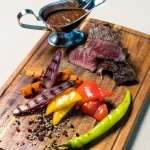Now Reading: Doctor-Recommended Foods to Naturally Boost Your Immune System in Africa
-
01
Doctor-Recommended Foods to Naturally Boost Your Immune System in Africa
Doctor-Recommended Foods to Naturally Boost Your Immune System in Africa









Here’s how to turn small spaces into cozy retreats with simple, affordable decor ideas that work for any style.
In 2007, the global food crisis highlighted the resilience and importance of traditional African food systems. Institutions and communities reaffirmed the value of local crops (millet, sorghum, yam) and plant-based diets, known not only for their sustainability but also for their nutritional density and immune-boosting properties. The focus was on indigenous solutions for feeding populations.
Fast forward to 2024, and the landscape looks different. African food, once celebrated for its hardiness and immune benefits, seems to be facing new challenges. Traditional diets are threatened by rapid urbanization, the massive import of processed foods, and a nutritional transition that exposes populations to new chronic diseases. Why has a food system that thrived during a previous crisis struggled to maintain its dominance today?
The Changing African Food Landscape
One of the biggest differences between 2007 and 2024 is the way diets have shifted. In 2007, local markets were still king for the majority, and traditional foods provided a simple, accessible way to maintain health. But in 2024, the landscape has radically changed. Supermarkets, fast food, and delivery platforms dominate the urban scene, offering consumers choices that go beyond what is available in the garden or at the market.
“Immune Diet” Fatigue
Another factor contributing to the decline in adherence to traditional immune diets in 2024 is a certain fatigue or lack of appreciation. The traditional African diet has been oversaturated with generic discourses on consuming millet, legumes, and leafy greens. What was once a natural habit has become a repetitive formula that struggles to compete with the glamour and convenience of processed foods. New food concepts, often imported, struggle to gain a foothold, while ancestral diets are either ignored or seen as a sign of poverty.
The rise of culinary influencers and social media has also blurred the lines of “good” eating. Platforms like Instagram and TikTok often promote Western diets or high-calorie dishes—with more visual appeal and less perceived nutritional authenticity than the simplicity of traditional foods.

The Rise of Competition: Processed Foods and Western Myths
Another problem encroaching on the space of traditional diets is the aggressive availability and marketing of processed foods. With sugary drinks, fried foods, and ready-to-eat meals taking center stage, consumers are turning to less nutritious but more convenient options.
These new eating habits are often cheaper or more accessible in urban areas, offering immediate satisfaction but little substance for the immune system. Agro-industry platforms invest heavily in this content, attracting consumers who would have previously relied on local food for natural immune support.
Ironically, the acceleration of the nutritional transition in 2024 has harmed the reputation of local foods more than it helped this time around. While they once provided an opportunity to dominate nutrition, the convenience of imported products has caused uncertainty across the entire local food system. Although traditional foods are naturally immune-boosting (yam, legumes, vegetables), many households now rely on expensive supplements and vitamins sold as a more “modern” and effective alternative.
Furthermore, governments and health institutions are less dependent on campaigns promoting local foods to fill nutritional gaps, thanks to the vast availability of imported food products (often subsidized), which has reduced reliance on local production solutions.
African food is not “dead”—it is evolving. While the traditional model faces difficulties, we may see a new era of innovation. Researchers and nutritionists will need to get more creative, offering new ways to consume staple foods, integrating elements of modern cuisine (fusion), or using technology to highlight their benefits. Short, impactful educational campaigns designed for digital platforms or new niche markets could help revive interest.
Ultimately, the challenges facing African food in 2024 reflect broader changes in our lifestyle. The diet that once thrived during a content drought in 2007 is now facing stiff competition from a wide array of processed and imported alternatives. To survive, the promotion of African foods will need to adapt to this new digital and urban landscape.
When we talk about healthy eating in Africa, we must first talk about returning to what our grandmothers knew how to do. The wisdom is in the field, not in the supermarket.
Professor Lindiwe Sibanda (Expert in sustainable agriculture, food security, and nutrition in Africa)
Consumers now expect clearer and higher quality information than ever before. Major food platforms offer highly commercialized products, making traditional foods look “outdated” by comparison. Furthermore, health institutions must themselves invest in promoting more targeted, niche offerings, such as highlighting local superfoods (Moringa, Hibiscus) that can be easily integrated.
The original appeal of traditional food came from its proven health benefits and connection to the land. But in 2024, social media has made quick fixes more appealing. Now, any product can be marketed as an “immune booster,” making it harder for African staple foods to maintain their position of natural authority.
The Impact of the Nutritional Transition in 2024
Ironically, the increasing reliance on processed foods has harmed the population’s immune potential more than it helped this time around. While local food once provided a natural way to strengthen the immune system, the shift in eating habits has caused uncertainty and a rise in non-communicable diseases (diabetes, hypertension).
Unlike 2007, when local foods were a must-have solution, today’s households have more options. Supermarkets, vast imports, and the ability to ignore seasonal products have reduced reliance on traditional diets. The 2024 transition has affected the African food ecosystem in ways that were not as pronounced in 2007, leaving local nutrition exposed to external influences.













